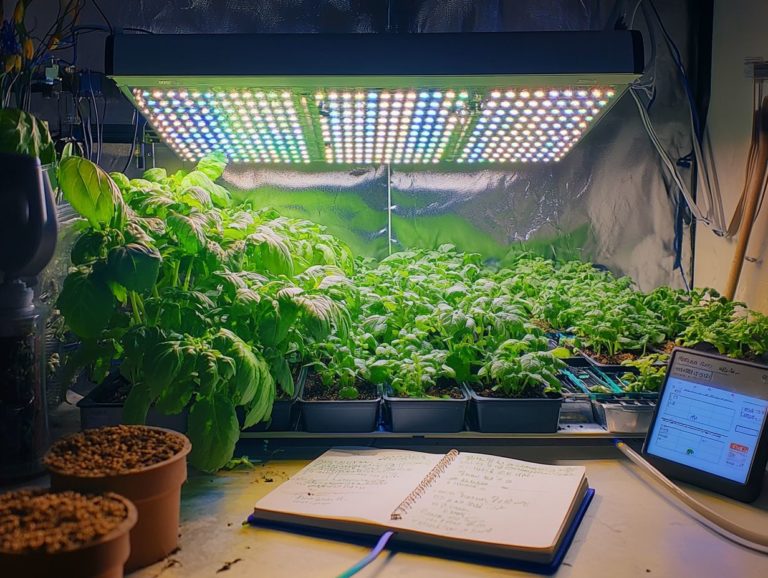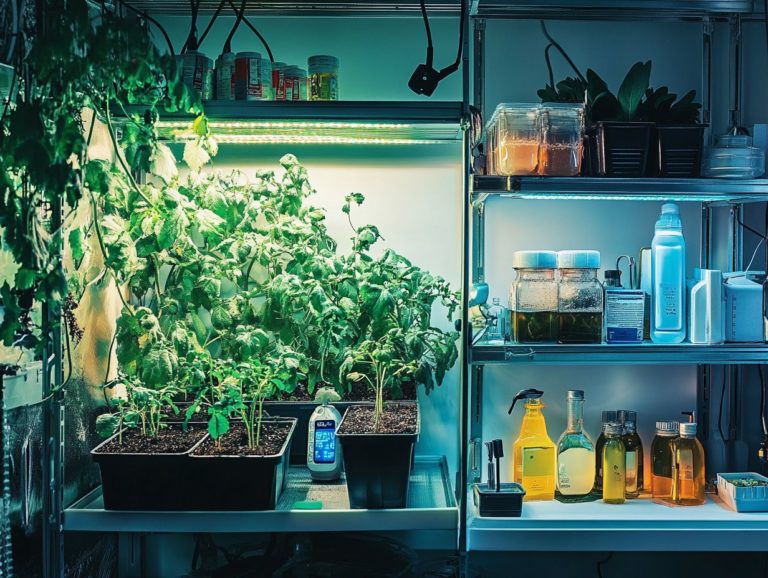Understanding Hydroponic Water Recirculation
Hydroponic systems, including hydroponic water recirculation, are revolutionizing how you grow plants, providing a sustainable and efficient approach to agriculture.
In this article, you will explore the definition and benefits of this advanced gardening method, including nutrient-filled water and optimal environmental conditions. You ll learn exactly how it functions and the essential components that make it work.
You ll uncover the advantages of recirculating water and optimizing nutrient levels while also considering potential challenges and practical solutions to overcome them.
We will share best practices to help you achieve great results, along with insights into the latest innovations in hydroponic gardens.
Dive into this exciting world of hydroponics and discover what s possible!
Contents
- Key Takeaways:
- Unlocking Hydroponic Water Recirculation: How It Transforms Gardening
- How Does Hydroponic Water Recirculation Work?
- Advantages of Water Recirculation in Hydroponics
- Potential Challenges and Solutions
- Best Practices for Hydroponic Water Recirculation
- Innovations in Hydroponic Water Recirculation
- Frequently Asked Questions
- What is the purpose of water recirculation in hydroponics?
- Why is hydroponic water recirculation crucial?
- How does water recirculation work in hydroponics?
- What types of systems use water recirculation in hydroponics?
- Are there any disadvantages to using water recirculation in hydroponics?
- How can I ensure successful water recirculation in my hydroponic system?
Key Takeaways:

- Hydroponic water recirculation is a method of reusing and filtering water in a closed system, providing numerous benefits like efficient nutrient absorption and reduced water waste.
- This process involves various components such as pumps, filters, and reservoirs, following a cycle of nutrient delivery, absorption, and recirculation for plant growth.
- Water recirculation in hydroponics can save costs and improve efficiency, while challenges like clogging and nutrient imbalances can be addressed through proper maintenance and troubleshooting.
Unlocking Hydroponic Water Recirculation: How It Transforms Gardening
Hydroponic systems like hydroponic water recirculation represent an advanced gardening method that employs closed-loop systems to enhance plant growth by continuously recycling a nutrient-filled water. This method, commonly used in hydroponic systems, optimizes water usage and guarantees that your plants receive the essential nutrients required for vigorous growth.
The result? Higher crop yields, particularly within controlled greenhouse environments. By embracing hydroponics, you can cultivate a diverse array of vegetables and fruits, all while minimizing water waste and maximizing space efficiency.
Definition and Benefits
Hydroponic water recirculation is a method where water and nutrient solutions are continuously cycled through a system, ensuring that your plants receive essential nutrients while conserving precious water resources.
This innovative approach accelerates plant growth rates far beyond traditional soil methods, as the roots have immediate access to nutrients. By effectively managing water use, it champions sustainable practices that are crucial in drought-prone areas, underscoring its importance in efficient water conservation.
This system gives you the power to cultivate a diverse array of vegetables, from leafy greens to fruiting crops, making it suitable for both home gardeners and commercial operations. Consequently, understanding the basics of hydroponic systems not only boosts productivity but also embraces environmentally-friendly farming techniques.
How Does Hydroponic Water Recirculation Work?
The process of hydroponic water recirculation encompasses several essential components. You’ll need a reservoir for your nutrient solution, efficient delivery systems, and diverse growing methods like deep water culture and nutrient film technique, where a thin film of nutrient water flows over the roots.
These elements work together to ensure optimal water quality, fostering ideal conditions for robust plant growth.
Components and Processes Involved
Key components of hydroponic water recirculation systems include an air pump that delivers oxygen to the nutrient solution, a reservoir to store those vital nutrients, and various growing media that support plant roots all of which require careful pH management.
The air pump is crucial, introducing oxygen into the nutrient solution, which enhances nutrient absorption and fosters robust root development. The reservoir serves as a reliable storage unit, maintaining nutrient solutions at ideal levels for efficient distribution while minimizing waste.
As for the growing media think rock wool or coconut coir they provide essential structural support while retaining moisture and nutrients vital for plant health.
Regularly monitoring your nutrient solutions is key; this ensures they are well-maintained, while proper pH levels facilitate optimal nutrient uptake. This attention to detail ultimately leads to vigorous plant growth and higher yields, making your hydroponic venture a resounding success.
Join the hydroponic revolution today and transform your gardening experience!
Advantages of Water Recirculation in Hydroponics

The advantages of water recirculation in hydroponics are numerous! You ll experience enhanced efficiency and impressive cost savings as it minimizes water usage while ensuring that your plants receive a perfectly balanced nutrient solution.
This method not only optimizes crop production but also aligns seamlessly with sustainable agricultural practices.
Efficiency and Cost Savings
Implementing hydroponic water recirculation systems leads to remarkable efficiency and cost savings. This is primarily achieved by reducing water consumption and optimizing nutrient delivery, which directly contributes to higher crop production.
These systems dramatically decrease the amount of water needed for cultivation compared to traditional farming methods, which often waste a substantial volume through evaporation and runoff.
For you as a grower, this translates to lower water bills and allows you to reallocate resources to other essential operations. The precision in nutrient administration minimizes fertilizer waste, ultimately reducing your overall input costs.
By maximizing yield per square foot, you can achieve shorter crop cycles and increased profitability. Hydroponics often eliminates the need for costly pesticides, making it not only an efficient choice but also a financially savvy one.
Potential Challenges and Solutions
While hydroponic water recirculation offers numerous benefits, be prepared for challenges! These can include the need to maintain optimal water quality, effectively manage nutrient levels, and ensure the proper pH balance within your hydroponic systems.
Common Issues and Troubleshooting
Common issues in hydroponic water recirculation include fluctuations in water quality, nutrient imbalances, and challenges in maintaining optimal conditions for your plants’ growth.
These problems can profoundly affect the health and productivity of your crops, potentially leading to stunted growth or even plant failures. For instance, an unexpected spike in pH levels can cause inability of plants to absorb nutrients, leaving your plants unable to take in essential minerals.
It’s crucial for you to regularly monitor pH and EC (electrical conductivity). Adjust these parameters swiftly to restore balance!
To keep your water free from contaminants and pathogens, routine checks are essential. Consider integrating filtration systems for added protection. Regularly assess moisture levels in your growing media to maintain adequate moisture without oversaturating the roots. For a deeper understanding of this process, refer to understanding the hydroponic nutrient cycle. Remember, overwatering can lead to root rot and other complications you definitely want to avoid!
Best Practices for Hydroponic Water Recirculation
To achieve optimal results in hydroponic water recirculation, adhere to best practices. This includes regularly monitoring nutrient levels, ensuring water quality is top-notch, and adapting your growing methods to cater to the specific needs of your plants.
Tips for Optimal Results

To achieve optimal results in hydroponic gardening, concentrate on maintaining nutrient balance and ensuring ideal environmental conditions. Use tools like air pumps to promote robust root systems in your plants!
By regularly monitoring pH levels and electrical conductivity, you can fine-tune the nutrient solutions to meet the specific needs of your plants. Keeping a vigilant eye on temperature and humidity levels is essential for preventing pests and diseases that tend to flourish in less-than-ideal environments.
Incorporating automation tools can streamline monitoring, ensuring that your system remains functional and efficient. Schedule periodic maintenance checks cleaning equipment and replacing worn parts to prevent disruptions in your hydroponic setup.
With these consistent efforts, successful yields and thriving plants are well within your reach! Start your hydroponic journey today!
Innovations in Hydroponic Water Recirculation
Innovations in hydroponic water recirculation are transforming agriculture. New technology increases energy efficiency and improves water conservation. These advancements create ideal growth conditions for a diverse range of plants, from vibrant vegetables like jalape os to succulent fruits.
New Technologies and Techniques
New technologies in hydroponics, such as advanced nutrient solutions and automated monitoring systems, are revolutionizing sustainable crop production. These innovations significantly enhance water conservation in hydroponic setups.
Among these innovations, smart watering methods stand out by greatly reducing water wastage. They ensure that plants receive only what they need while minimizing runoff and evaporation.
The integration of smart sensors that connect to the internet allows for real-time data collection. You can monitor environmental conditions and dynamically adjust nutrient levels, enhancing plant growth while conserving valuable resources like water and electricity.
Closed-loop water recirculation systems optimize nutrient use and reduce reliance on chemical fertilizers. This fosters a more eco-friendly approach to agriculture.
Frequently Asked Questions
What is the purpose of water recirculation in hydroponics?
The purpose of water recirculation in hydroponics is to conserve and reuse water, nutrients, and other resources. This maintains a consistent and controlled environment for plant growth.
Why is hydroponic water recirculation crucial?

Understanding hydroponic water recirculation is important because it helps improve plant growth, increase efficiency, and reduce waste in hydroponic systems. It also allows for greater control and customization of the growing environment!
How does water recirculation work in hydroponics?
In hydroponic water recirculation, water is continuously pumped through the system. It passes through the growing medium, delivering nutrients to the plants’ roots. Excess water is then collected, filtered, and recirculated, reducing the need for frequent water changes.
What types of systems use water recirculation in hydroponics?
Most hydroponic systems, including deep water culture, ebb and flow, and drip systems, utilize some form of water recirculation. However, specific methods and equipment may vary depending on the system type and the plants’ needs.
Are there any disadvantages to using water recirculation in hydroponics?
One potential disadvantage of water recirculation is the risk of disease and nutrient imbalances if the water is not properly monitored and maintained. Additionally, some systems may require more complex and expensive equipment for effective water recirculation.
How can I ensure successful water recirculation in my hydroponic system?
To ensure successful water recirculation, regularly monitor and maintain the pH, nutrient levels, and overall cleanliness of the water. Installing a filtration system and using high-quality nutrients can significantly improve water recirculation and plant growth!






